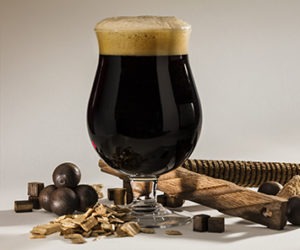Stainless Steel Care: Tips From the Pros
 Ashton Lewis — Former Master Brewer at Springfield Brewing Company in Springfield, Missouri
Ashton Lewis — Former Master Brewer at Springfield Brewing Company in Springfield, Missouri
Stainless steel is a terrific material used for brewing equipment because it is resistant to corrosion, easy to weld, affordable, and malleable. This makes it a good metal to use in cold-forming operations such as tube and tank fabrication.
Properly treating equipment is important because stainless steel is not indestructible. The following tips should help to keep stainless steel tools in good condition for decades of dependable service.
#1 – Handle with care
Stainless steel is relatively easy to polish, and sanitary equipment is polished to make cleaning easier. Polishing also makes for an aesthetically pleasing appearance on exterior surfaces. This ease of polishing also means that stainless steel is relatively easy to scratch. The easiest way to reduce the risk of scratching is by handling with care and by avoiding touching the surface of your equipment with anything that results in scratches. Common culprits of equipment scratches are cleaning pads, cleaning abrasives, and contact with other metal tools.
Green scrubbing pads used to clean cookware can quickly ruin polished surfaces because these pads contain bits of mineral crystals bonded to the fibers of the pad causing scratches to the surface. Not only do green pads damage the beauty of uniform surfaces, they can also make cleaning progressively more difficult if repeatedly used. White-colored cleaning pads, Teflon meshes, and natural fiber pads can be used on polished equipment.
Abrasives are also used in many household cleaning products, such as Comet, Ajax, Barkeeper’s Friend, and Soft Scrub. All of these products are capable of scratching stainless surfaces and should be generally avoided, or cautiously used after testing.
#2 – Say no to bleach
Sodium hypochlorite bleach causes pitting corrosion, especially when the pH becomes acidic. Although short exposure times are not likely to cause problems, for example as a dip to sanitize spoons and whisks, stainless steel equipment should never be in contact with bleach solutions for any length of time. Most brewers simply avoid using bleach because of the risk to equipment and to beer flavor.
#3 – Chemical cleaning can be your friend
Chemical cleaning is the most effective and least problematic method used to clean stainless steel. Alkaline detergents, such as sodium carbonate, sodium metasilicate, trisodium phosphate and sodium hydroxide, can be used to remove organic soils without any risk of equipment corrosion. Acetic acid (white vinegar) and phosphoric acid are good choices to remove mineral scale from equipment. Although chemical cleaning is the preferred method for large-scale cleaning, it is important to know the ingredients used in chemicals for two reasons; safety and corrosion. Know what you are using so you don’t inadvertently use a cleaner that will damage your equipment. Mild detergents and soft cleaning cloths or brushes can be used on many of the soils encountered in the brewery.
 Ben Caya — President of Spike Brewing in Milwaukee, Wisconsin
Ben Caya — President of Spike Brewing in Milwaukee, Wisconsin
There are some “essential” brewery chemicals I think every brewer should have on hand: Dish soap — Upon receiving any piece of stainless equipment, I recommend using a good dish soap, hot water and some elbow grease. The dish soap will break down any oils or dirt that are present from the manufacturing process. Alkaline brewery chemical — Brewery wash is great for post-brew clean up. Alkaline Brewery Wash (ABW) and Powdered Brewery Wash (PBW) are designed to break down organic material, so it is great for soaking stainless accessories/parts or soaking in your stainless vessel. We recommend running an alkaline brewery chemical through your system at the end of a brew day to clean the inside of valves, hoses, pumps, etc.
There are also a couple misconceptions about stainless. Passivation — as it relates to stainless steel, means creating a very thin (only a few atoms thick) oxide layer on top of the underlying stainless steel material. This oxide layer acts as a barrier and helps give stainless its ‘stainless’ properties. The misconception is that harsh chemicals or even Star-San should be used to passivate. The truth is stainless steel naturally passivates (almost instantly). The dish soap scrub described earlier would be plenty to passivate your new piece of stainless equipment. Rust — many brewers believe stainless can’t rust and get very concerned if they see a couple specs of rust on their equipment. The truth is stainless steel is approximately 70% iron, which rusts very easily. The chromium and nickel added to this iron mixture is what makes stainless rust resistant . . . but not rust-proof.
Lastly, there are a couple no-no’s when it comes to stainless. Bleach — never use bleach on stainless steel. Bleach can cause stainless to corrode and pit. Abrasive Scrubbing Pads — the green scrubbing pads are too abrasive for polished stainless and can cause scratches. Always use a non-abrasive pad when cleaning. Steel Wool — steel wool can impregnate the surface with iron and cause rusting.
 Ashton Lewis — Former Master Brewer at Springfield Brewing Company in Springfield, Missouri
Ashton Lewis — Former Master Brewer at Springfield Brewing Company in Springfield, Missouri
 Ben Caya — President of Spike Brewing in Milwaukee, Wisconsin
Ben Caya — President of Spike Brewing in Milwaukee, Wisconsin

